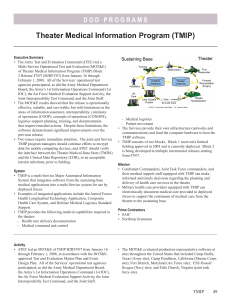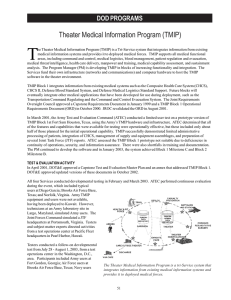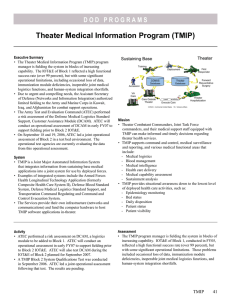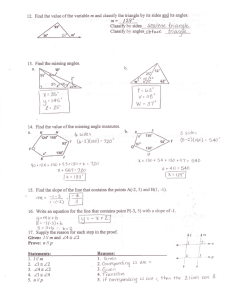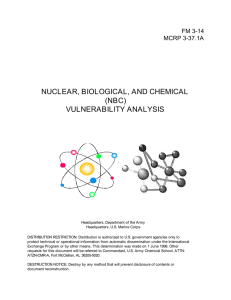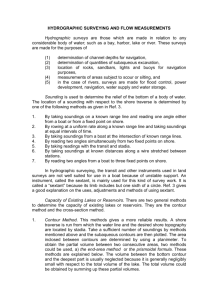Theater Medical Information Program (TMIP) DOD PROGRAMS
advertisement
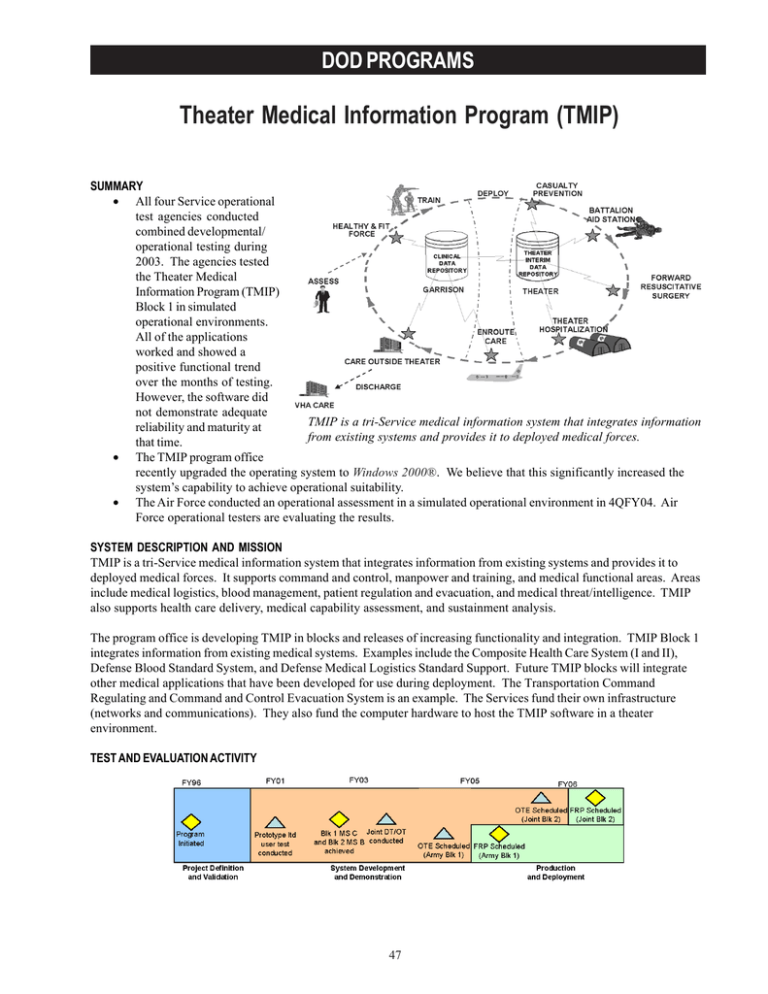
DOD PROGRAMS Theater Medical Information Program (TMIP) SUMMARY • All four Service operational test agencies conducted combined developmental/ operational testing during 2003. The agencies tested the Theater Medical Information Program (TMIP) Block 1 in simulated operational environments. All of the applications worked and showed a positive functional trend over the months of testing. However, the software did not demonstrate adequate TMIP is a tri-Service medical information system that integrates information reliability and maturity at from existing systems and provides it to deployed medical forces. that time. • The TMIP program office recently upgraded the operating system to Windows 2000®. We believe that this significantly increased the system’s capability to achieve operational suitability. • The Air Force conducted an operational assessment in a simulated operational environment in 4QFY04. Air Force operational testers are evaluating the results. SYSTEM DESCRIPTION AND MISSION TMIP is a tri-Service medical information system that integrates information from existing systems and provides it to deployed medical forces. It supports command and control, manpower and training, and medical functional areas. Areas include medical logistics, blood management, patient regulation and evacuation, and medical threat/intelligence. TMIP also supports health care delivery, medical capability assessment, and sustainment analysis. The program office is developing TMIP in blocks and releases of increasing functionality and integration. TMIP Block 1 integrates information from existing medical systems. Examples include the Composite Health Care System (I and II), Defense Blood Standard System, and Defense Medical Logistics Standard Support. Future TMIP blocks will integrate other medical applications that have been developed for use during deployment. The Transportation Command Regulating and Command and Control Evacuation System is an example. The Services fund their own infrastructure (networks and communications). They also fund the computer hardware to host the TMIP software in a theater environment. TEST AND EVALUATION ACTIVITY 47 DOD PROGRAMS DOT&E approved a Capstone Test and Evaluation Master Plan and a TMIP Block 1 Annex in April 2001, followed by approval of an updated version in October 2002. During 2001, the Army Test and Evaluation Command, the lead operational test agency, conducted a limited user test on a prototype version of TMIP Block 1 at Fort Sam Houston, Texas. Led by the Army, operational testers from all four Services assisted the program office in conducting combined developmental/operational testing in a simulated operational environment during March and April 2003. The event included typical users at Diego Garcia; Brooks Air Force Base, Texas; and Norfolk, Virginia. Army TMIP equipment and users were not available, having been deployed to Kuwait. Technicians at an Army laboratory site in Largo, Maryland, simulated Army users. Joint Forces Command simulated a joint task force headquarters in Portsmouth, Virginia. Testers and subject matter experts directed activities from a test operations center at Pacific Fleet headquarters in Pearl Harbor, Hawaii. Operational testers conducted another combined developmental/operational test during the summer of 2003. It included Army users at Fort Gordon, Georgia; Air Force users at Brooks Air Force Base, Texas; Navy users aboard two ships of the 7th Fleet; Marine Corps users in Okinawa; and a Joint Task Force headquarters simulated by Joint Forces Command. In February 2004, DOT&E approved an Event Design Plan for the Air Force to use for operational testing. With some adaptation, the plan is comprehensive enough to be used by all the Services. In August 2004, the Air Force Operational Test and Evaluation Center conducted an operational assessment of TMIP Block 1 at Fort Detrick, Maryland, using a simulated field environment. The Air Force is still evaluating the results of that assessment. Independent OT&E was not practicable during FY03 or FY04 due to the real world deployment of potential users and other factors. However, the Army Test and Evaluation Command plans to conduct OT&E of Block 1 for the Army in 2QFY05. Further OT&E will probably await the next software release, TMIP Block 2 Release 1. The program office plans to deliver the new release to the Services for preliminary test and evaluation in May 2005. The operational test community plans to conduct a joint OT&E of TMIP Block 2 Release 1 sometime between 1QFY06 and 3QFY06. They hope to conduct this test in conjunction with a joint exercise. TEST AND EVALUATION ASSESSMENT Developmental testing during 2003 showed that all of the planned TMIP Block 1 applications worked. Users received, processed, and displayed required information from multiple sources at a joint task force headquarters. The testers conducted the testing in a simulated user environment. They showed that computer systems aboard Navy ships could be adapted to use TMIP. They transmitted medical information to a fleet headquarters, which then forwarded it to a joint task force. Following the testing, the Navy retained its TMIP hardware and software for real world use aboard two Seventh Fleet ships and at Pacific Fleet headquarters. The Army currently uses TMIP Block 1 in Kuwait and Iraq. The developmental testing in a simulated user environment was not strictly operational testing. However, the Service operational test agencies ran the test. The Army Test and Evaluation Command prepared a system assessment in November 2003. TMIP displayed a positive functional trend. In over 6,000 attempts, the success rate for critical mission functions climbed from 86 percent in March 2003 to 98 percent by August 2003. TMIP has the potential to be operationally suitable. The one major exception was its reliance on an obsolete operating system, Windows NT®. During 2004, the program office upgraded TMIP to Windows 2000®. This should have significantly increased TMIP’s potential to achieve operational suitability. Additionally, the TMIP software was not sufficiently mature or reliable. Installation and setup needed improvement and Service concepts of operation needed refinement. Testers will focus on these suitability areas during future OT&E. The testers did not gather enough data to demonstrate survivability. They need to do more testing of system backup and restoration. Also, field spot checks found several shortfalls in information assurance. The results of the Air Force operational assessment should provide additional insight to the status of TMIP. We will further assess the system as soon as the Army is able to test Block 1. We will perform our primary assessment of TMIP upon completion of joint operational testing of Block 2. 48
